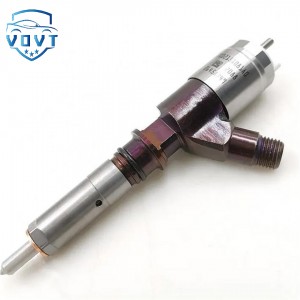New High Quality Diesel Injector 232-1198 10R-1274 239-4908 249-0705 10R-7236 For CAT C13
Products Description
| Reference. Codes | C13 |
| Application | C13 |
| MOQ | 4PCS |
| Certification | ISO9001 |
| Place of Origin | China |
| Packaging | Neutral packing |
| Quality Control | 100% tested before shipment |
| Lead time | 7~10 working days |
| Payment | T/T, L/C, Paypal, Western Union, MoneyGram or as your requirement |
Diesel injector characteristics optimization: the key to solving engine emission problems
The combustion process of a diesel engine is essentially a violent chemical reaction between fuel and air under high temperature and high pressure. The mission of the injector is to inject diesel into the cylinder with precise pressure, timing and form, and dominate the rhythm and efficiency of combustion. Its core characteristics include:
Injection pressure: determines the fineness of fuel atomization. The higher the pressure, the easier it is for the fuel to break into micron-sized droplets and mix more evenly with the air.
Injection timing: controls the starting time of fuel injection. Early injection will prolong the combustion time, and delay may lead to incomplete combustion.
Spray characteristics: including spray cone angle, range and oil mist particle distribution, directly affect the spatial distribution of fuel in the cylinder.
Flow characteristics: the law of change of injection volume over time determines the energy release rhythm of the combustion process.
If the injector characteristics do not match the engine operating conditions, it will directly cause uncontrolled combustion and lead to a surge in pollutants:
Insufficient injection pressure: rough fuel atomization, forming a local rich mixture, incomplete combustion, PM (soot particles) and unburned hydrocarbon (HC) emissions soar.
Premature fuel injection: Combustion starts early in the compression stroke, the cylinder temperature is too high, and a large amount of NOx (the product of the reaction of nitrogen and oxygen at high temperature) is generated.
Poor spray morphology: The fuel is sprayed onto the cylinder wall or the top of the piston, forming a "wet wall" phenomenon, causing oil dilution and incomplete combustion, and increasing CO emissions.
Extensive flow control: The initial injection volume is too large, resulting in strong combustion explosion and sudden temperature rise, which aggravates the generation of NOx; the later oil volume is insufficient, and unburned fuel remains.
(I) High pressure: Make the fuel "as fine as dust"
The high-pressure common rail technology is used to increase the injection pressure from the traditional 100MPa to more than 200MPa. For example, a heavy-duty diesel engine reduces the particle size of fuel atomization from 50 microns to less than 15 microns by increasing the pressure to 250MPa, and PM emissions are reduced by 40%. High-pressure injection allows the fuel and air to mix more fully, accelerates the combustion speed, and greatly reduces the amount of carbon smoke generated. At the same time, with variable pressure control, the pressure is appropriately reduced (such as 150MPa) at low load to avoid the increase of NOx due to excessive combustion temperature.
(II) Flexible timing: "brake" combustion
With the help of electronic control unit (ECU), dynamic adjustment of injection timing is achieved:
Pre-injection technology: 5%-10% of fuel is injected before the main injection to form a "small flame" in the cylinder, reduce the peak combustion pressure during the main injection, and reduce NOx emissions by 20%-30%. For example, after a certain car diesel engine uses pre-injection, NOx is reduced from 2.5g/kWh to 1.8g/kWh.
Post-injection strategy: After the main injection, a small amount of fuel is injected, and the high-temperature gas in the exhaust is used for secondary combustion, which can increase the carbon soot oxidation rate in PM to more than 30%, and also has a purification effect on HC and CO.
(III) Intelligent spray: Let the fuel "hit wherever you point it"
By optimizing the structure of the fuel injector, the spray pattern and the combustion chamber can be precisely matched:
Multi-spray hole design: From the traditional 4 holes to 8-10 holes, the spray cone angle is widened from 70° to 120°, so that the fuel can evenly cover the combustion chamber space. After a certain agricultural diesel engine switched to an 8-hole nozzle, PM emissions decreased by 35% and fuel consumption decreased by 5%.
Gradient particle size control: Using "two-stage" spray, fine particles (<20 microns) are sprayed out in the early stage to quickly form a combustible mixture, and coarse particles (30-50 microns) are sprayed out in the later stage to extend the combustion duration, taking into account both combustion efficiency and emission control.
With the penetration of the Internet of Things (IoT) and artificial intelligence (AI) technologies, injector optimization is moving towards a new level:
Real-time closed-loop control: Through the in-cylinder pressure sensor and emission sensor, the ECU adjusts the injection parameters in real time. For example, when NOx is detected to be excessive, the injection timing is automatically delayed by 0.5-1° crankshaft angle, and the emission can be brought up to standard within 2 seconds.
Big data predictive maintenance: Using the cloud data platform, analyze the historical data of tens of thousands of injections of the injector, and warn of nozzle wear, oil circuit blockage and other faults in advance to avoid emission deterioration caused by component aging.
Optimizing the characteristics of diesel injectors is essentially to find a dynamic balance between combustion efficiency and emission control. From mechanical injection to electronic control, from single parameter adjustment to multi-dimensional collaborative optimization, this process is not only a technological innovation, but also an ultimate pursuit of the concept of "precise control". With the approach of the National VII emission regulations, injector technology will form a synergistic effect with hybrid technology, alternative fuels, etc., and promote diesel engines to continue to lead in the dual tracks of environmental protection and energy efficiency.





















